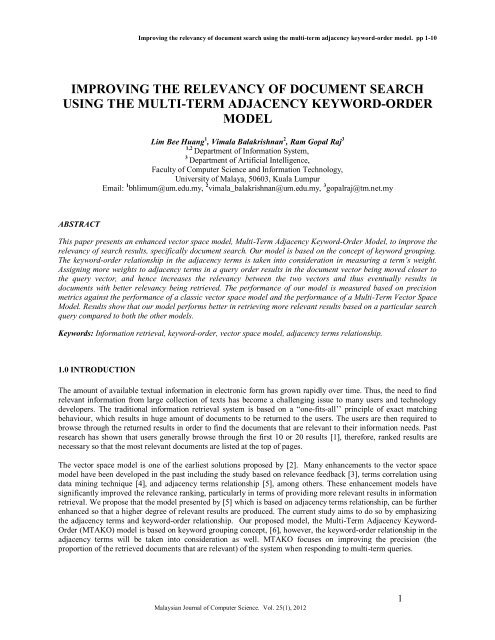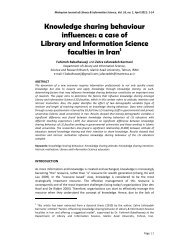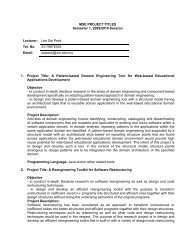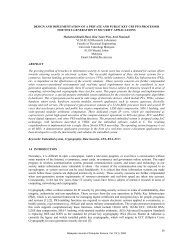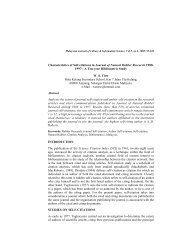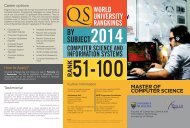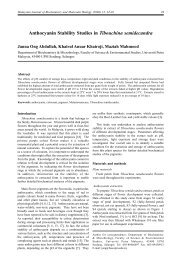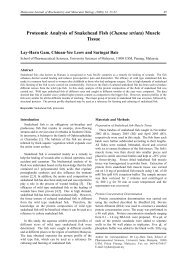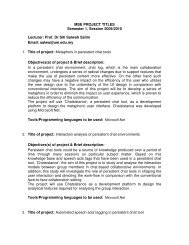IMPROVING THE RELEVANCY OF DOCUMENT SEARCH ... - EJUM
IMPROVING THE RELEVANCY OF DOCUMENT SEARCH ... - EJUM
IMPROVING THE RELEVANCY OF DOCUMENT SEARCH ... - EJUM
You also want an ePaper? Increase the reach of your titles
YUMPU automatically turns print PDFs into web optimized ePapers that Google loves.
Improving the relevancy of document search using the multi-term adjacency keyword-order model. pp 1-10<strong>IMPROVING</strong> <strong>THE</strong> <strong>RELEVANCY</strong> <strong>OF</strong> <strong>DOCUMENT</strong> <strong>SEARCH</strong>USING <strong>THE</strong> MULTI-TERM ADJACENCY KEYWORD-ORDERMODELLim Bee Huang 1 , Vimala Balakrishnan 2 , Ram Gopal Raj 31,2Department of Information System,3Department of Artificial Intelligence,Faculty of Computer Science and Information Technology,University of Malaya, 50603, Kuala LumpurEmail: 1 bhlimum@um.edu.my, 2 vimala_balakrishnan@um.edu.my, 3 gopalraj@tm.net.myABSTRACTThis paper presents an enhanced vector space model, Multi-Term Adjacency Keyword-Order Model, to improve therelevancy of search results, specifically document search. Our model is based on the concept of keyword grouping.The keyword-order relationship in the adjacency terms is taken into consideration in measuring a term’s weight.Assigning more weights to adjacency terms in a query order results in the document vector being moved closer tothe query vector, and hence increases the relevancy between the two vectors and thus eventually results indocuments with better relevancy being retrieved. The performance of our model is measured based on precisionmetrics against the performance of a classic vector space model and the performance of a Multi-Term Vector SpaceModel. Results show that our model performs better in retrieving more relevant results based on a particular searchquery compared to both the other models.Keywords: Information retrieval, keyword-order, vector space model, adjacency terms relationship.1.0 INTRODUCTIONThe amount of available textual information in electronic form has grown rapidly over time. Thus, the need to findrelevant information from large collection of texts has become a challenging issue to many users and technologydevelopers. The traditional information retrieval system is based on a “one-fits-all’’ principle of exact matchingbehaviour, which results in huge amount of documents to be returned to the users. The users are then required tobrowse through the returned results in order to find the documents that are relevant to their information needs. Pastresearch has shown that users generally browse through the first 10 or 20 results [1], therefore, ranked results arenecessary so that the most relevant documents are listed at the top of pages.The vector space model is one of the earliest solutions proposed by [2]. Many enhancements to the vector spacemodel have been developed in the past including the study based on relevance feedback [3], terms correlation usingdata mining technique [4], and adjacency terms relationship [5], among others. These enhancement models havesignificantly improved the relevance ranking, particularly in terms of providing more relevant results in informationretrieval. We propose that the model presented by [5] which is based on adjacency terms relationship, can be furtherenhanced so that a higher degree of relevant results are produced. The current study aims to do so by emphasizingthe adjacency terms and keyword-order relationship. Our proposed model, the Multi-Term Adjacency Keyword-Order (MTAKO) model is based on keyword grouping concept, [6], however, the keyword-order relationship in theadjacency terms will be taken into consideration as well. MTAKO focuses on improving the precision (theproportion of the retrieved documents that are relevant) of the system when responding to multi-term queries.Malaysian Journal of Computer Science. Vol. 25(1), 20121
Improving the relevancy of document search using the multi-term adjacency keyword-order model. pp 1-102.0 VECTOR SPACE MODELSVector space model is a statistical model that models documents and queries as vectors in a multi-dimensionalspace, [2]. The relevancy of a document is judged statistically by computing the cosine of the angle between thedocument vector and query vector. When the distance between document and query vectors is short in the documentspace, they are conceptually similar and relevant to the users, [7]. However, the representations of terms in classicvector space model are assumed to be mutually independent, resulting in a loss of term location (position) in thedocument, [5]. Therefore, a document with two query terms “information” and “retrieval” that are far-apart inlocation is considered as relevant as a document with query terms that occur next to each other, such as “informationretrieval”. [5] showed that query terms that appear close to each other constitute more relevant documents than farapartterms in the document.3.0 <strong>THE</strong> ADJACENCY KEYWORDS GROUPING CONCEPTAccording to [6], a document may contain keywords found either as standalone (not next to any other keywords) orin groups with other adjacency keywords. For example, a search query of “information retrieval system”, and theadjacency terms in a document that possibly found to be keywords are as shown in Table 1.Table 1: Possible keywords in document for “information retrieval system”Group TypeAdjacent KeywordsStandalone keywords"information", "retrieval", "system"Group with 2 keywords"information retrieval", "information system", "retrieval system","system information", "system retrieval", "retrieval information"Group with 3 keywords"information retrieval system", "retrieval system information", "systemretrieval information", "retrieval information system"With the search query of three keywords, the maximum size of the keyword group is equivalent to the size of thequery keywords, which, is three in the above example. In general, for a search query of N keywords, it will contain amaximum of N keyword groups. If the number of adjacent keywords, n is more than N, repeated keywords willoccur in the group (e.g. information retrieval system retrieval). In this case, the repeated keyword (i.e. retrieval) istreated as a non-keyword in the query processing. The idea of grouping the keywords in a document is motivated bythe assumption that terms found in keyword group should be more significant to the document and given moreweight than standalone terms, [6].4.0 MULTI-TERMS ADJACENCY KEYWORDS ORDER (MTAKO) MODELThe proposed model in this study is based on two main assumptions:Assumption 1: If a document contains a keyword group and the terms within the group are in the order defined bythe query, this document is assumed to be more relevant than a group without any keyword-order within them.Assumption 2: The higher the number of keywords in the query order (measured in keyword-order pairs) within thegroup, the higher the relevancy of the document.Malaysian Journal of Computer Science. Vol. 25(1), 20122
Improving the relevancy of document search using the multi-term adjacency keyword-order model. pp 1-10For example, assume a search query contains the keywords in the order of {information, retrieval, system,performance, evaluation} and with four documents in the collection as below:Doc 1: contains {information, retrieval, system, performance}Doc 2: contains {information, retrieval, performance, system}Doc 3: contains {information, system, performance, evaluation}Doc 4: contains {retrieval, performance, information, evaluation}The keyword-order pairs found within the group in the documents are shown in Table 2.Table 2: Keyword order pairsDocumentDoc 1Doc 2Doc 3Doc 4Keyword Order Pairsinformation-retrieval, retrieval-system, system-performanceinformation-retrievalsystem-performance, performance-evaluationBased on the assumptions, Doc 1 has three keyword-order pairs in the keyword group and it is assumed to be themost relevant, followed by Doc 3 and Doc 2. The least relevant document would be Doc 4 that has no keywordorderpairs within the keyword group.If any two consecutive terms in a pair within the group match the keyword in the order defined by the query, thisgroup is then considered a keyword-order group. It is then assigned more weight to show the importance of termsthat appear in the keyword-order group. The number of keyword-order pairs is incorporated into the weightfunction to compute the term weight according to the size of the keyword group, the group order and the number ofkeyword-order pairs in which the term occurs.5.0 MTAKO VECTOR PROCESSINGConsider a sample text documents collection with query illustrated as in Table 3.Table 3: Sample document collectionQuery: Shipment of gold and silverDoc NoD1D2D3ContentShipment of gold and silver damaged in a fireOrder of gold and silver delayed in a shipmentShipment of silver and gold arrived in a truckMalaysian Journal of Computer Science. Vol. 25(1), 20123
Improving the relevancy of document search using the multi-term adjacency keyword-order model. pp 1-10The search process begins with scanning the first document D1 sequentially from the first term to the last. Then foreach term, the term that is found to be a keyword will be added to the keyword array (the purpose of the keywordarray is to group all the adjacency keywords together). To construct the document vector, the information needed areterms, keyword group size, keyword group order, term frequency and number of keyword-order pairs that exist.Term frequency is accumulated each time the term occurs in the document. Keyword group size is computed basedon the size of the keyword array, whereas the keyword group order and number of keyword-order pairs aredetermined based on the pseudo-code shown in Fig 1.Input: keyword array, query arrayOutput: keyword group order, keyword-order pairsBegin…For each term in keyword arrayGet the position in query array where term matches keywordGet next term in keyword arrayGet next keyword in query arrayCompare next term with next keywordIf next term = next keyword,Set keyword group order = 1Increment keyword-order pair by 1…EndFig. 1. Pseudo-code for determining the keyword group order and keyword-order pairsAfter all the terms have been scanned, the term-by-group matrix is computed for the documents. In term-by-groupmatrix, rows correspond to terms in the document; columns correspond to keyword group and cells correspond tofrequency of term occurrence in the keyword group. Table 4 shows the term-by-group matrix for document vectorD1. The types of group are denoted as Type 1 for standalone keywords, Type 2 for group with two keywords, Type3 for group with three keywords.Malaysian Journal of Computer Science. Vol. 25(1), 20124
Improving the relevancy of document search using the multi-term adjacency keyword-order model. pp 1-10Table 4: Term-by-group matrix for D1Non Keyword-order GroupKeyword-order GroupTerm Type 1 Type 2 Type 3 Type 2 Type 3shipment 0 0 0 0 1gold 0 0 0 0 1silver 0 0 0 0 1damage 1 0 0 0 0fire 1 0 0 0 06.0 TERM WEIGHT ASSIGNMENTThe proposed weight function F(n,g,k), is defined as an exponentially increasing function based on group size,group order and the number of keyword-order pairs found in the group. It can be written as shown in Formula (1).2 n-1 , when g = 0 (for non keyword-order group)F(n,g,k) =k (2 n-1 ), when g = 1 (for keyword-order group) and,k = Number of keyword-order pairs(1)Thus, for a document vector D i expressed in {w i,1 , w ,i,2 , …, w i,M }, the new term weight x j, corresponding to elementw i,j of vector D i is then computed as the summation of weight in all corresponding group type as shown in Formula(2).Nx j = ∑ w j,n F(n,0) + ∑ w j ,n * F(n,1)Nn =1 n=2NN= ∑ w j,n * 2 n-1 + ∑ w j,n * k * 2 n-1NN(2)n=1 n=2Where,n = size of the groupk = number of keyword-order pairsw j,n = frequency of term occurrence found in the groupFor query vector Q expressed in {w q,1 , w q,2 , …, w q,M }, the query weight w q,j, corresponding to each term j is givenvalue of 1 when term j is a keyword or zero when term j is a non-keyword.The resulting document vector D1 and query vector is as presented in Table 5.Malaysian Journal of Computer Science. Vol. 25(1), 20125
Improving the relevancy of document search using the multi-term adjacency keyword-order model. pp 1-10TermTable 5: Document and query vector representation for D1Group 0 Group 11 2 3 2 3TermWeight x jQueryWeight w q,jshipment 0 0 0 0 1 8 1gold 0 0 0 0 1 8 1silver 0 0 0 0 1 8 1damage 1 0 0 0 0 1 0fire 1 0 0 0 0 1 07.0 SIMILARITY MEASUREThe similarity between document and query vectors can be calculated using cosine measure, [8], as shown inFormula (3).sim(Q ,D i ) =Q ∙ D i(3)| Q | | D i |M∑ x i,j * w q,j= j=1M M√ ∑ x 2 i,j * √ ∑ w 2 q,jj = 1 j = 18.0 SYSTEM PERFORMANCE EVALUATIONThe effectiveness of the proposed model was evaluated using precision metric, which measures the number ofrelevant retrieved results. It is the proportion of retrieved documents that are relevant and is defined as Formula (4)below:Precision =Number of relevant retrieved (4)94Total number retrievedThe results of the proposed MTAKO model was compared with the classic vector space model (Classic VSM) andMulti-Term Vector Space Model (MTVSM), both of which are not based on keyword-order relationship. Theproposed model was also measured in terms of the percentage of average precision improvement of the Top-20retrieved results.Malaysian Journal of Computer Science. Vol. 25(1), 20126
Improving the relevancy of document search using the multi-term adjacency keyword-order model. pp 1-109.0 EXPERIMENT SETUPSample data from Communications of the ACM (CACM) collection was setup for the experiment. The search isbased on the titles and abstracts of articles from the collection. A set of 15 randomly picked queries from thecollection was manually converted to keyword-based queries to suit the proposed keyword-based searchenvironment.10.0 RESULTSThe experiments were performed on three different ranking models: MTAKO, MTVSM and classic VSM. Thecomparison of the system performances will include the query-by-query average precision, precision histogram,precision at cut-off rank and mean average precision.Table 6 shows the query-by-query average precision analysis depicting the number of queries for which MTAKOachieved higher average precision (+), lower average precision (-) or same average precision (=) for a query.Table 6: Query-by-query average precision analysisModels ComparisonPrecision Differences+ - =TotalQueriesMTAKO – MTVSM 12 3 0 15MTAKO – Classic VSM 11 4 0 15Table 6 shows that MTAKO achieved 12/15 queries with average precision higher than MTVSM and achieved11/15 queries with average precision higher than classic VSM. The higher average precision values indicate thatmore of the highly ranked documents were relevant, [[9], clearly showing that MTAKO model outperformed boththe MTVSM and classic VSM models for the Top-20 retrieved documents.The average precision obtained for each of the queries is further analyzed for its difference in percentage usingprecision histogram. Let M A be the system with model A and M B be the system with model B, if the averageprecision percentage difference is zero, this indicates that M A has the same level of performance with M B for a query.A positive percentage difference (> 0%) implies that performance of M A is better while a negative percentagedifference (< 0%) implies that the performance of M A is worse than M B .Fig 2(a) shows the performance comparison between MTAKO and MTVSM while Fig 2(b) shows the comparisonbetween MTAKO and classic VSM models.Malaysian Journal of Computer Science. Vol. 25(1), 20127
Improving the relevancy of document search using the multi-term adjacency keyword-order model. pp 1-10Fig. 2. Precision histogram for average precision performance comparisonPerformance comparison between MTAKO – MTVSM revealed better performance for 12 queries (Q1, Q2, Q3, Q4,Q5, Q6, Q7, Q8, Q11, Q12, Q13, Q14) and worse performance for 3 queries (Q9, Q10, Q15). The higher averageprecision differences for the 12 queries demonstrate that MTAKO is more effective, and thus performs better thanMTVSM. Similarly, the performance comparison between MTAKO – classic VSM shows that MTAKO revealedbetter performance for 11 queries (Q1, Q2, Q3, Q4, Q5, Q6, Q7, Q8, Q11, Q12, Q13, Q14) and worse performancefor only 4 queries (Q9, Q10, Q15), indicating that MTAKO performs better than classic VSM model.The average precision at the cut-off rank of Top-5, Top-10, Top-15 and Top-20 retrieved documents for MTAKO,MTVSM and classic VSM are shown in Table 7.Table 7: Average precision at cut-off rankAverage PrecisionCut-off rank MTAKO MTVSM Classic VSM5 0.4000 0.4000 0.440010 0.3733 0.3467 0.326715 0.3111 0.3067 0.297820 0.2533 0.2500 0.2700The results show that at cut-off rank of Top-5 and Top-20 retrieved documents, classic VSM outperforms both theMTAKO and MTVSM models. However, for the majority of the retrieved documents (from 6th to 15th retrieveddocuments) at cut-off rank of Top-10 and Top-15 , MTAKO shows higher average precision values than MTVSMand classic VSM, indicating that more relevant documents are retrieved in this range. This shows that MTAKOmodel performs better than MTVSM and classic VSM.Finally, the mean average precision provides another way of comparing the system performance that reflects theperformance over all the relevant documents. Table 8 shows the mean average precision values achieved byMTAKO (56.97%), MTVSM (50.14%) and classic VSM (55.55%) over the 15 queries, clearly indicating MTAKOperforms the best among the three models.Malaysian Journal of Computer Science. Vol. 25(1), 20128
Improving the relevancy of document search using the multi-term adjacency keyword-order model. pp 1-10Table 8: Mean average precisionModel Mean average precision (%)MTAKO 56.97%MTVSM 50.14%Classic VSM 55.55%The MTAKO model gives an average precision improvement of 6.83% over MTVSM and 1.42% over Classic VSMfor the Top-20 retrieved documents. Again, this proves that the overall performance of MTAKO model is superiorcompared to MTVSM and classic VSM.9.0 CONCLUSION AND FUTURE WORKThis study introduced an enhanced relevance ranking technique for information retrieval based on vector spacemodel. The proposed model focuses only on precision that favors to system which retrieves relevant documentsquickly, that is early in the ranking. Classic vector space model and Multi-Term Vector Space Model work well inretrieving most of the relevant documents but, with additional consideration of terms adjacency in keyword-orderrelationship in Multi-Term Adjacency Keywords Order (MTAKO) model tends to improve the precision in theoverall retrieved results. Some of the future research to enhance MTAKO is to include indexing approach that mayimprove the system efficiency. The current study performed the document indexing during runtime in which theindexes were not pre-processed in the collections. This may incur high processing cost in a very large textcollection. Future work may also explore on efficiency of indexing method in the system. The semantic technologysuch as the study of the meaning of terms or words of the query may be explored to further increase the retrievaleffectiveness of the search results as discussed in [[10]. Other further research would be to incorporate the relevancefeedback technique (a technique to reformulate the original query based on the feedback from the initial queryresults), [[10]. As presented in [10], the use of a VSM based scheme is very useful in even natural languageprocessing (NLP). If our model were combined with that shown in [10], it could potentially give MTAKO a newavenue of usefulness in the area of NLP.REFERENCES[1] A. M. Z. Bidoki, P. Ghodsnia, N. Yazdani and F. Oroumchian, “A3CRank: An adaptive ranking methodbased on connectivity, content and click-through data”, Information Processing and Management, 2010, Vol.46: pp. 159–169.[2] G. Salton, A. Wong and C. S. Yang, “A vector space model for automatic indexing”, Communications of theACM, November 1975, Vol. 18(11), pp. 613-620.[3] X. Tai, F. Ren and K. Kita, An Information Retrieval Model based on Vector Space Method by SupervisedLearning, Information Processing and Management, 2002, Vol. 38, pp. 749–764.[4] I. R. Silva, J. N. Souza and K. S. Santos, “Dependence Among Terms in Vector Space Model”, Proceedingsof the International Database Engineering and Applications Symposium (IDEAS’04), 2004.[5] L.S. Wang, “Relevance Weighting of Multi-Term Queries for Vector Space Model”, IEEE, 2009.[6] L.S. Wang and D.X. Wang, “Method for ranking and sorting electronic documents in a search result list basedon relevance”, U.S.Patent Application Publication US 2007/0179930 A1, January 31, 2006.[7] D. L. Lee, H. Chuang and K. Seamons, “Document Ranking and the Vector Space Model”, Software, IEEE,1997, Vol. 14(2): pp. 67-75.Malaysian Journal of Computer Science. Vol. 25(1), 20129
Improving the relevancy of document search using the multi-term adjacency keyword-order model. pp 1-10[8] G. Salton, E. A. Fox and H. Wu, “Extended Boolean Information Retrieval”, Communications of the ACM,December 1983, Vol. 26(12).[9] R.B. Yates, and B.R. Neto, “Modern Information Retrieval”, Addison Wesley Longman, 1999.[10] R.G. Raj and V. Balakrishnan, “A Model for Determining the Degree of Contradictions in Information”.Malaysian Journal of Computer Science, September 2011, Vol. 24(3): pp. 160-167.[11] G. Salton and C. Buckley, “Improving Retrieval Performance by Relevance Feedback”, Journal of theAmerican Society for Information Science, 1997, Vol. 41(4), pp. 288-297.BIOGRAPHYLim Bee Huang is a student in University of Malaya (UM) attached to the Department of Information Systems. Shehas just completed her Masters studies in the field of information retrieval.Vimala Balakrishnan holds a PhD from Multimedia University (MMU). She is currently a senior lecturer at theDepartment of Information System of the Faculty of Computer Science and Information Technology at UM. Herwork deals with information security, information retrieval and data and knowledge engineering.Ram Gopal Raj holds a PhD from the University of Malaya (UM) and is attached with the Department of ArtificialIntelligence of the Faculty of Computer Science and Information Technology at UM. His research is mostly relatedto chatterbot technology and information search methods as well as knowledge representation schemes.Malaysian Journal of Computer Science. Vol. 25(1), 201210


